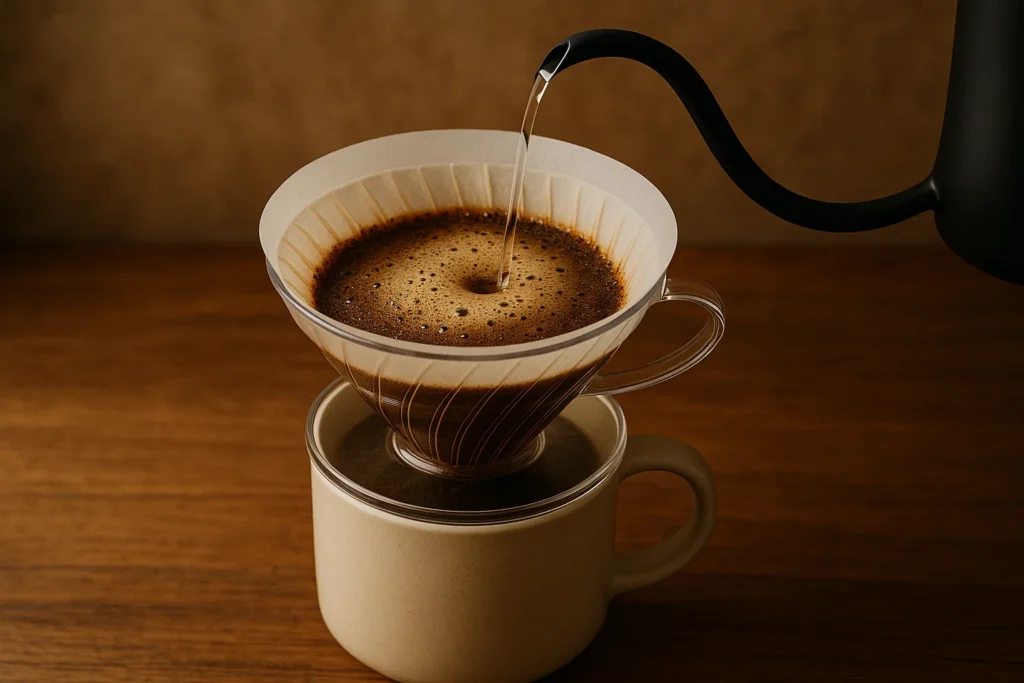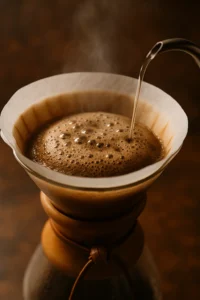Home » Coffee Knowledge » home-brewing » What Is Blooming in Coffee Brewing?

Ever noticed how coffee grounds puff up like a rising soufflé the moment hot water hits them? If you’ve made a pour-over, you’ve probably seen this up close—it’s called the bloom, and it’s more than just a pretty moment. Blooming is the release of carbon dioxide (CO₂) from freshly ground coffee when it first comes into contact with water. Think of it as the coffee’s way of taking a deep breath before diving into extraction. It only lasts about 30–45 seconds, but that quick fizz sets the stage for the flavors to come. Skip it, and you might just be sabotaging your cup before it even starts.
The bloom isn’t just for show – it directly affects flavor and extraction. CO₂ in the grounds is slightly sour and highly repellent to water. If you don’t let it escape, that gas will fight the water’s entry into the coffee. In practical terms, skipping the bloom often leads to a flat, under-extracted brew. In taste tests, cups brewed without a bloom were described as “flatter” and more acidic than those that were bloomed. That acidity happens because CO₂ was rushing out while the water was trying to get in, so the water couldn’t extract the full flavor profile of the beans. Simply put, failing to degas means losing aroma and sweetness – and inviting a harsh taste into the cup.
Chemically, roasting traps CO₂ inside coffee beans. As soon as hot water hits the grounds, that pent-up gas escapes in a foamy rush. You can actually visualize this: the coffee bed will foam and swell (in a pour-over) or form a bubbly “raft” on top (in a French press). This occurs for about 30–60 seconds before settling.
During this phase, water can’t effectively penetrate the grounds, because all the pore space is occupied by gas. Blooming by wetting the grounds first is like pausing to let a crowd exit a room before letting new people in – it creates space for water to properly saturate the coffee. Once the foaming subsides, the way is clear for water to extract oils and flavors without resistance.
Technique: To bloom correctly, pour just enough hot water to thoroughly wet the grounds (a common guideline is about 2 grams of water per 1 gram of coffee). For example, if you use 20g of coffee, start with ~40g of water. Use water just off the boil (around 90–96°C) and pour gently in a spiral to avoid channeling. After pouring, wait about 30–45 seconds. During this time you’ll see bubbling begin and eventually slow down. As the coffee “puffs” up and then starts to settle or “burp”, that’s your cue to proceed with the rest of the pour. Stirring or swirling very gently can help break the crust of coffee at the surface and release trapped gas.
Timing: The exact bloom time can vary. Very fresh beans (a day or two after roast) may foam for a full minute, while older beans degas faster (often within 20–30 seconds). Watch the coffee itself more than a stopwatch – once the foaming slows to a trickle (the “burp”), begin pouring the rest of the water. This blooming strategy ensures the hot water isn’t fighting gas on its way into the grounds. Remember, a longer bloom means slightly higher extraction yield, but also more heat lost from the brew and kettle. In practice, most brewers find 30–45 seconds to be a sweet spot for balanced flavor.
Water Ratio: The “2:1” water rule is a good starting point. Some guides even suggest roughly twice the water to coffee during bloom. After the bloom pause, continue brewing with your chosen pour-over schedule or brewing method. For immersion methods like French press or AeroPress, blooming still happens when you first combine water and coffee – you’ll see similar bubbling. (In fact, cold brew aficionados often skip a formal bloom step because they use cold water and very coarse grind, but even there, pre-wetting coarse grounds for a minute or so can improve consistency.)
 James Hoffmann – former World Barista Champion and coffee educator – has weighed in on blooming. He notes that coffee practice is full of debates, and bloom time is one of them. In his Weird Coffee Science series, Hoffmann even experimented with “hard blooms” in hard water. He quips about being “lazy” and trying to minimize brew time, but he agrees that completely skipping the bloom is unwise.
James Hoffmann – former World Barista Champion and coffee educator – has weighed in on blooming. He notes that coffee practice is full of debates, and bloom time is one of them. In his Weird Coffee Science series, Hoffmann even experimented with “hard blooms” in hard water. He quips about being “lazy” and trying to minimize brew time, but he agrees that completely skipping the bloom is unwise.
In fact, Hoffmann recommends just watching the coffee itself: pour the bloom water and wait until it “puffs up” and then settles. Only then add more water. This approach – rather than a strict timer – lets you adapt to each bean’s freshness and roast.
For more on his experiments, check out James Hoffmann’s video Weird Coffee Science: The Hard Bloom on YouTube: Watch here.
In summary, blooming coffee is a simple yet crucial trick for better flavor. It’s a free step (no special gear needed) that avoids unwanted sourness and ensures fuller extraction. Next time you pour-over at home, give your grounds a 30-second spa session – you’ll likely notice a rounder, sweeter cup when you finish the brew.
At first glance, blooming coffee might seem like a minor detail—just a quick fizz of bubbles before the real action starts. But in reality, it’s a key moment that can dramatically improve the taste, aroma, and balance of your brew. By allowing carbon dioxide to escape, you’re not only avoiding sour or uneven flavors, you’re unlocking the coffee’s full potential.
This isn’t just a technique for coffee snobs or pros with fancy kettles. Whether you’re using a pour-over, French press, or even experimenting with AeroPress, giving your grounds 30–45 seconds to bloom is one of the simplest ways to level up your morning ritual. It’s small, free, and incredibly effective.
So if you’ve ever wondered why your coffee tastes flat or sour, don’t overlook the bloom. Treat it like a warm-up for your beans—and a mindful moment for you. Your taste buds will thank you.
If you want to practice your blooming skills, check out these home brewing recipes on Coffee Slang:

Welcome to Coffee Slang—I’m Nick Puffer, a former barista turned coffee enthusiast. What started behind the counter became a passion I now share with others. Join me as we explore the craft, culture, and lifestyle of coffee.
We care a lot about the experience you have with coffee. A lot of work has gone into getting great beans to your door.
Get Updates From Us When We Create New Ways To Explore Coffee!